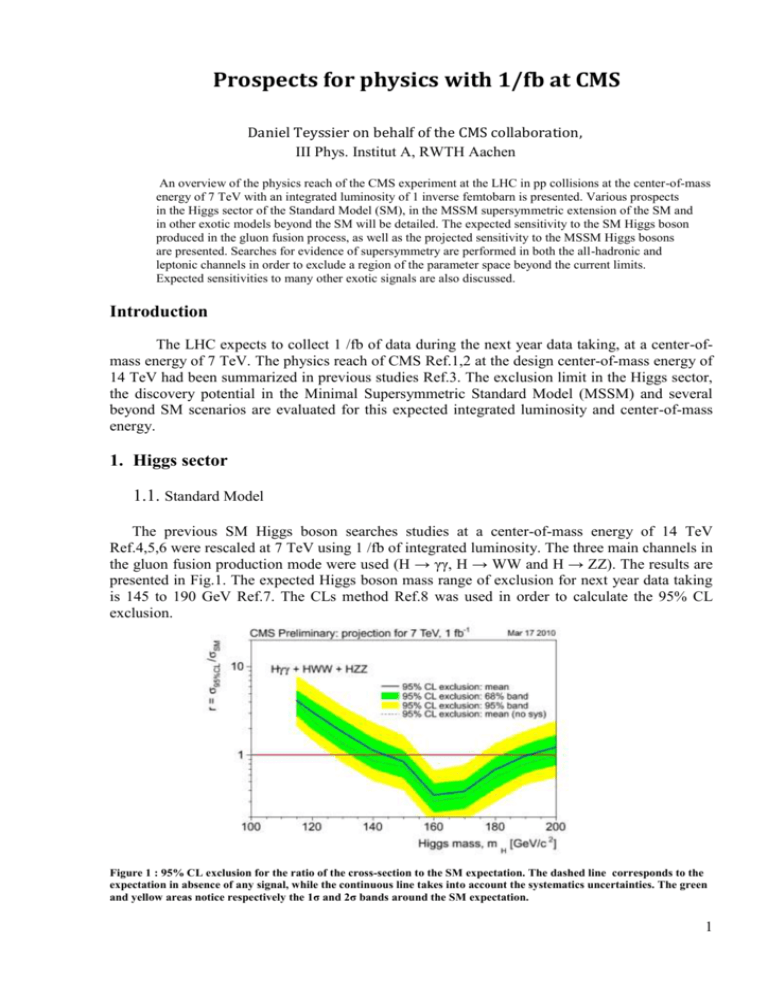Teyssier - Indico
advertisement

Prospects for physics with 1/fb at CMS Daniel Teyssier on behalf of the CMS collaboration, III Phys. Institut A, RWTH Aachen An overview of the physics reach of the CMS experiment at the LHC in pp collisions at the center-of-mass energy of 7 TeV with an integrated luminosity of 1 inverse femtobarn is presented. Various prospects in the Higgs sector of the Standard Model (SM), in the MSSM supersymmetric extension of the SM and in other exotic models beyond the SM will be detailed. The expected sensitivity to the SM Higgs boson produced in the gluon fusion process, as well as the projected sensitivity to the MSSM Higgs bosons are presented. Searches for evidence of supersymmetry are performed in both the all-hadronic and leptonic channels in order to exclude a region of the parameter space beyond the current limits. Expected sensitivities to many other exotic signals are also discussed. Introduction The LHC expects to collect 1 /fb of data during the next year data taking, at a center-ofmass energy of 7 TeV. The physics reach of CMS Ref.1,2 at the design center-of-mass energy of 14 TeV had been summarized in previous studies Ref.3. The exclusion limit in the Higgs sector, the discovery potential in the Minimal Supersymmetric Standard Model (MSSM) and several beyond SM scenarios are evaluated for this expected integrated luminosity and center-of-mass energy. 1. Higgs sector 1.1. Standard Model The previous SM Higgs boson searches studies at a center-of-mass energy of 14 TeV Ref.4,5,6 were rescaled at 7 TeV using 1 /fb of integrated luminosity. The three main channels in the gluon fusion production mode were used (H → γγ, H → WW and H → ZZ). The results are presented in Fig.1. The expected Higgs boson mass range of exclusion for next year data taking is 145 to 190 GeV Ref.7. The CLs method Ref.8 was used in order to calculate the 95% CL exclusion. Figure 1 : 95% CL exclusion for the ratio of the cross-section to the SM expectation. The dashed line corresponds to the expectation in absence of any signal, while the continuous line takes into account the systematics uncertainties. The green and yellow areas notice respectively the 1σ and 2σ bands around the SM expectation. 1 1.2. MSSM In the MSSM Higgs sector, the bbΦ final state was considered, where Φ stands for any of the three neutral Higgs bosons h, H or A. The decay studied is Φ → ττ. Several final states were combined : τ1 → µνν and τ2 into pion(s) Ref.9 τ1 → eνν and τ2 into pion(s) Ref.10, τ1 → eνν and τ2 → µνν Ref.11. The results are presented in Fig.2, where the red dashed line represents the discovery potential in the plane (mA,tanß) and the solid blue line shows the expected 95% CL exclusion. The excluded regions from LEP and Tevatron are also shown. The expected 95% CL exclusion will go beyond previous data. Figure 2 : 95% CL exclusion for the bbΦ search, with Φ being one of the three neutral Higgs bosons (h, H or A) decaying into ττ. The excluded regions by LEP and Tevatron are also shown. 2. Supersymmetry searches The search for Supersymmetry (SUSY) are presented in the specific mSUGRA scenario Ref.12, reducing the MSSM parameters to only five parameters : m0, m1/2, tanß, A0 and sign(µ). The different final states contain high pT jets, large missing transverse energy (MET) and eventually some isolated leptons coming from the SUSY cascade. 2.1. Hadronic channel We consider the final state with high pT jets and large MET, but no isolated leptons with high pT. Several SM backgrounds need to be measured using data-driven methods Ref.13, in particular the QCD multijets with fake MET. In Fig.3 the expected exclusion limit is shown using 1 /fb of data Ref.7. 2 Figure 3 : 95% CL exclusion limits in the hadronic channel in the plane (m0,m1/2). 2.2. Like-sign dilepton channel Besides the different possible leptonic final states, the like-sign dilepton channel allows to supress strongly the SM backgrounds, that have opposite sign dilepton final states. As this is a less inclusive channel, the sensitivity presented in Fig.4 shows a less extended area in the plane (m0,m1/2) than the hadronic channel. But using 1 /fb of data, the exclusion limits Ref.7 should go beyond the current Tevatron limit. Figure 4 : 95% CL exclusion limits in the leptonic channel in the plane (m0,m1/2). 3. Exotica models Several beyond SM models, called exotica, have a potential of discovery including the next year data taking. We present a set of examples of such scenarios. 3.1. Large extra dimensions The large extra dimensions (LED) could be observed using several final states (monojet, dimuon, diphoton). The previous studies Ref.14 were scaled to the center-of-mass energy of 3 7 TeV and 1 /fb of integrated luminosity. Fig.5 shows the potential of discovery for the LED in the γγ channel. Figure 5 : 95% CL exclusion limit for LED in the γγ channel . 3.2. Randall-Sundrum gravitons The Randall-Sundrum (RS) model allows to probe a warped extra dimension. The RS gravitons are also searched in the γγ channel, allowing the comparison with the LED. Fig.6 presents the potential of discovery in the same conditions, scaling the previous study Ref.15. The potential of discovery is present for several sets of RS model parameters. Figure 6 : 95% CL exclusion limit for RS gravitons. 3.3. Leptoquarks In Grand Unified Theories, Technicolor and composite models, some exotic particles carry both baryon and lepton numbers. The first generation leptoquarks (LQ) searches were summarized in Ref.16. Fig.7 shows the updated study. The LQ will decay into leptons and quarks. The ß parameter represents the branching fraction of the LQ into eq. The three generations of LQ correspond also to the families of SM quarks and leptons. 4 Figure 7 : 95% CL exclusion limit for the first LQ generation. 3.4. Heavy stable charged particles Different models predict some Heavy Stable Charged Particles (HSCP) : others sets of parameters in mGMSB model (stau), Universal Extra Dimension (UED) models also (quasistable sleptons), or split SUSY (model with high scalar masses) that permits also the existence of long lived gluino. The HSCP could be lepton-like (stau) or hadron-like (gluino or stop). In the last case, gluino and stop will hadronize to get R-hadrons (R-baryons, R-mesons or R-glueball). Previous studies were summarized in Ref.17 and Fig.8 shows the potential of discovery. Figure 8 : 95% CL exclusion limit for the HSCP particles. Conclusions The physics reach of CMS at a center-of-mass of 7 TeV using 1 /fb of data shows the possibility to extend the current exclusion limits in the Higgs sector of SM and MSSM. The SUSY searches using next year data taking will cover a large area of the parameter space, while exotica scenarios have a broad potential of discovery. 5 Acknowledgments This work was supported by the BMBF (Bundesministerium für Bildung und Forschung). REFERENCES [1] CMS Collaboration, Technical proposal, CERN/LHCC 94-038 (1994). [2] CMS Collaboration, The CMS experiment at the CERN LHC, JINST 3:S08004 (2008). [3] CMS Collaboration, CMS Technical Design Report, Vol. II: Physics Performance, J. Phys. G 34, 995 (2007). [4] CMS Collaboration, Search Strategy for a Standard Model Higgs Boson Decaying to Two W Bosons in the Fully Leptonic Final State, CMS PAS HIG-2008/006. [5] CMS Collaboration, Search strategy for the Higgs boson in the ZZ(*) decay channel with the CMS experiment, CMS PAS HIG-2008/003. [6] M. Pieri et al., Inclusive Search for the Higgs Boson in the H → γγ Channel, CMS NOTE 2006/112. [7] CMS Collaboration, The CMS physics reach for searches at 7 TeV, CMS NOTE-2010-008. [8] A.L. Read, Modified frequentist analysis of search results (the CLs method), CERN-OPEN2000-205; J. Phys. G 28, 2693 (2002). [9] A. Kalinowski et al, Search for MSSM heavy neutral Higgs boson in τ + τ → µ + jet decay model, CMS NOTE-2006/105. [10] R. Kinnunen and S. Lehti, Search for the heavy neutral MSSM Higgs bosons with the H/A → ττ → electron + jet decay model, CMS NOTE 2006/075. [11] S. Lehti, Study of MSSM H/A → ττ → eµ + X in CMS, CMS NOTE 2006/101. [12] A. Chamseddine. R. Arnowitt and P. Nath, Phys. Rev. Lett. 49, 970 (1982); E. Cremmer, P. Fayet, and L. Girardello, Phys. Lett. B 122, 41 (1983). [13] CMS Collaboration, Performance of Methods for Data-Driven Background Estimation in SUSY Searches, CMS PAS SUS-10-001 (2010). [14] CMS Collaboration, CMS PAS EXO-09-004 (2009). [15] CMS Collaboration, CMS PAS EXO-09-009 (2009). [16] CMS Collaboration, CMS PAS EXO-08-010 (2008). [17] CMS Collaboration, CMS PAS EXO-08-003 (2008). 6




